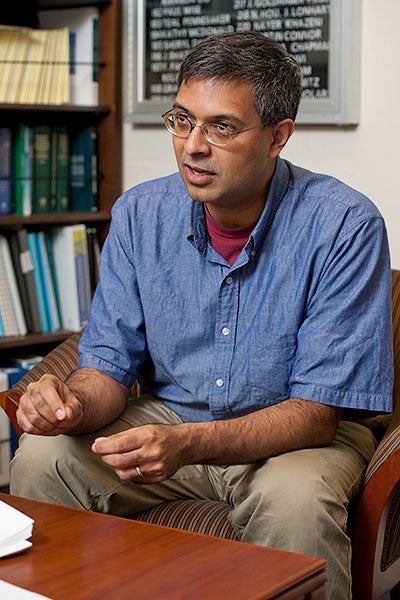|
March 29, 2012
Q&A: Stanford's Dr. Jay Bhattacharya explains what's at stake over health care
With legal arguments at the Supreme Court over, the fate of the Obama administration's health care law is in the hands of the justices. Stanford's Jay Bhattacharya, a professor of medicine and a health economist, explains how consumers could be affected. By Brooke Donald

Dr. Jay Bhattacharya is an associate professor of medicine and a health economist at Stanford. (Photo: L. A. Cicero / Stanford News Service) The U.S. Supreme Court has wrapped up three days of arguments over the nation's sweeping health care reform law.
At issue is whether the government is allowed to require that every American have health insurance coverage or pay a penalty, and whether Congress has the power to expand the Medicaid program for the poor, as called for in the law passed two years ago.
Much of the law doesn't go into effect until 2014, and a decision from the court is not expected until June.
Stanford's Dr. Jay Bhattacharya, an associate professor of medicine and a health economist with the Freeman Spogli Institute's Center for Health Policy, spoke with the Stanford News Service about the law and what the effect would be on consumers should the court throw it out, toss part of it or keep it all.
"The goal of the law is to insure another 35 million people by 2020," Bhattacharya explains. "But someone has to pay for that. And how to do that has generated a lot of controversy."
What's under attack?
There are two major parts of the law, in addition to the hundreds of regulations and other provisions. There is the large expansion of Medicaid, which is the federal and state health plan for the poor. And there is a provision called the individual mandate that requires people to buy insurance or face a penalty. These are the provisions the court is tackling.
Many legal scholars and court watchers believe the individual mandate will be struck down by the court. What happens then?
The reason why there is a mandate is to help pay for the expansion of care. The younger, healthier person essentially helps pay for the older, sicker person not yet eligible for Medicare – those people in their late 50s, early 60s. In effect, health insurers have a larger pool of insured under the mandate so they can afford to take on a less healthy and more expensive clientele.
If you didn't have the mandate, then many of those young people would say, "It doesn't seem like a good deal for me," and really it's not a good deal for them, and that would make it harder for older people to get affordable care.
So no mandate equals more expensive care for some?
Yes. The main effect of throwing out the mandate would be that the older population who does not get health insurance through their employer would be paying more to be insured. And an estimated 15 million people who would be insured under the law now would choose to go without insurance.
What if the court tosses the Medicaid provision?
The effects of the justices' decision on Medicaid are much more straightforward. If the provision is cut down, the 20 million people who were to be covered by 2020 won't have insurance.
If these people remain uninsured, does it make health care more expensive in general?
There's a debate among health economists over this. Suppose you don't have insurance and you break your arm. You go to the emergency room and they treat you anyway. The provider, who doesn't want to eat the loss, then shifts the costs onto other people to subsidize the uninsured, in part. It's called cost-shifting. But there's debate over how much affect that has on premiums. Some people say small, some say large.
Is there a way to calculate the costs to society of not having 35 million more people insured?
You could do such a calculation but I don't think it would be meaningful. The meaningful political trade-off is insuring 35 million versus paying $200 billion or so in costs each year to keep them insured. How do you finance all that and who pays for it versus how good is it to have 35 million extra people with insurance? That's the big question. And often it's a political one more than economical.
-30-
|